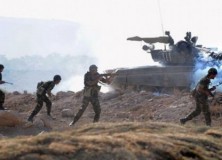U.S. Strategy in the Nagorno-Karabakh Conflict — Irina Ghaplanyan

INTRODUCTION:
Struggle over territorial control of Nagorno-Karabakh has proven one of the most intractable and longstanding conflicts stemming from the dissolution of the former Soviet Union. The enclave has a long and volatile pre-Soviet history. When the Soviet Union collapsed and its republics proclaimed their independence, the Nagorno-Karabakh legislature decided to establish itself as an independent state. As a result, by 1992, Azerbaijan and Nagorno-Karabakh (backed by Armenian troops and other military support) were engaged in full-scale war. In 1994, Armenia, Azerbaijan and Nagorno-Karabakh signed a Russia-brokered ceasefire but no final settlement has been reached. In the first 10 years after the independence of the Soviet Republics, U.S. policy toward the Caucasus was marked by a distinct lack of direction. Once the United States located strategic interests in the region, the guiding principle in the U.S. strategy towards the Nagorno-Karabakh conflict became the preservation of peace and prevention of military hostilities between Armenia and Azerbaijan. However, U.S. efforts to broker a lasting peace through the OSCE Minsk Group, the only acting international mediator of the Nagorno-Karabakh conflict, have continued without success.
STRATEGY:
The early response of the U.S. government to the Nagorno-Karabakh conflict was ad hoc. However, by the end of 1990s and early 2000s, the approach became more systematic as Washington began to identify clear American interests in the region, ranging from oil in the Caspian to offsetting Russia’s influence. This led to more integrated and in-depth cooperation between U.S. government agencies and the formulation of a more coherent regional strategy. Under the Clinton administration this strategy aimed primarily at developing energy cooperation with Azerbaijan. However, the terrorist attacks of 9/11 reshuffled foreign policy priorities; the Caucasus became more geostrategically significant and the U.S. government began to conduct more aid programs, deliver more assistance and make more frequent attempts at the conflict resolution.
INTEGRATED ELEMENTS OF NATIONAL POWER:
The first decade of American involvement in Nagorno-Karabakh and U.S. strategy to resolve the conflict was marked by an absence of interagency cooperation within the U.S. government. In the late Clinton administration, due to increased U.S. oil interests in the region, policy implementation was concentrated in the Departments of State and Energy. This stage was marked by closer cooperation of U.S. agencies working primarily in energy related programs. Despite Section 907 of the Freedom Support Act, which denied Azerbaijan American aid, the U.S. government endorsed major funding for oil exploration in the Caspian, which directly benefited the government of Azerbaijan. Section 907 was waived only in 2002 by President Bush, and has since been waived on an annual basis every year. By the late 1990s and early 2000s, cooperation was again suffering due to a failure to integrate political, economic, and security goals with those of conflict resolution. It was not until the last five years that interagency cooperation proved to be more successful.
EVALUATION:
A lack of awareness about the Nagorno-Karabakh conflict and the region at large was a major reason for the weakness in early U.S. policy planning. Strategy development was particularly difficult due to insufficient knowledge of the history, ethnicities, and religion of the region’s people. Moreover, fierce bureaucratic squabbling over jurisdictions in combination with efforts of domestic interests and lobby groups to push their own South Caucuses agendas led to a divided U.S. regional policy. About a decade ago, however, the U.S. response began to acquire more coherence and direction. The major strength of the U.S. response to the Nagorno-Karabakh conflict today is its perceived impartiality (in contrast to Russia and France, who are seen as more pro-Armenian). This neutrality is expressed in the style of American mediation efforts, in the equal provision of U.S. financial aid and assistance to both Armenia and Azerbaijan, and in the balance and cooperation between the U.S. Congress (seen as pro-Armenian) and the State Department (seen as pro-Azerbaijani). Congress has acquired its Armenia preferences in part because substantial numbers of congressmen have large Armenian populations in their respective states. Meanwhile the State Department tends to support the Azeri position because of Azerbaijan’s geostrategic importance and oil wealth.
RESULTS:
The absence of a coherent strategy in the early stages of the conflict and mixed political and strategic U.S. priorities confused the parties to the conflict and the countries of the region about the true American position. As a result, instead of bringing the countries of the region together, Washington contributed to their division. Improved strategy and greater engagement after 9/11 has facilitated more productive cooperation with regional states: including socio-economic initiatives, and democracy promotion programs. This has proven significant in staving off the possible resumption of military hostilities over Nagorno-Karabakh.
CONCLUSION:
The United States was not ready to develop a coherent or coordinated strategy for the Nagorno-Karabakh conflict and the region at large in the early- and mid-1990s. Even after Washington prioritized vested energy and strategic interests in the region, policy development and implementation remained insufficiently integrated. While the U.S. strategy is more coherent today than any point since the end of the Cold War, successes have been tactical and not strategic. Overall, U.S. economic, energy, and security goals are undermined by continuing instability in the region, something Washington has not been able to advance.